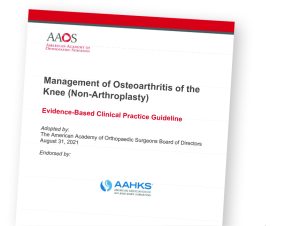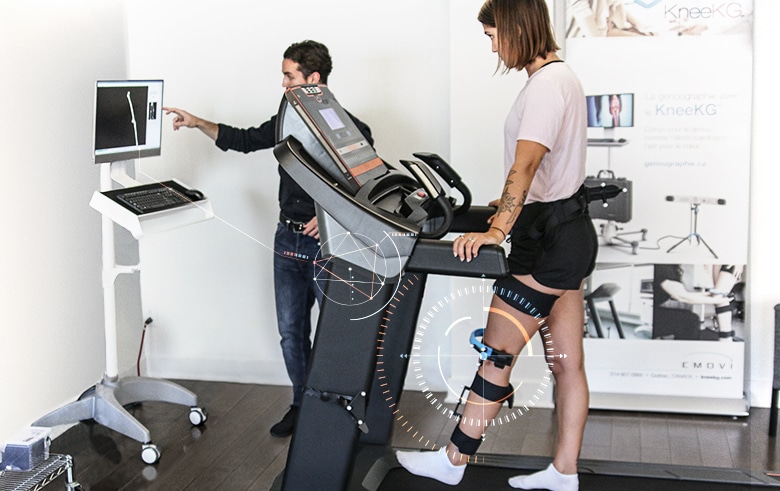What is a Knee Kinesiography exam?
The first 3D solution to a 3D problem.
Knee Kinesiography with the KneeKG system offers a technological edge in decision making to better correct knee alignment and restore 3D knee function
In restoring knee function and correcting the knee alignment, the challenge is we use two-dimensional images for a three-dimensional problem. The KneeKG is the first solution to help providers deliver diagnostic accuracy in all three planes of movement.
Providing 3D alignment data, the KneeKG allows for a:
- Reduction of pain and the risks of complications/aggravations throughout the episode of care
- Control of the yielded results
- Gain in efficiency
Gait Lab in a Box

How is a Knee Kinesiography performed with the KneeKG® System?
The test can be administered by a clinical assistant in a doctor’s office, or an imaging, sports or rehabilitation clinic, trained by Emovi. Results are immediately available to the doctor.
The knee attachment system “exoskeleton”, designed to eliminate movement artifact of the skin and muscles, is placed on the patient’s lower limb. Using an optical system, 3D knee kinematics are captured during walking on a conventional treadmill at a self-determined comfortable speed, in a dynamic, weight-bearing context. Data are captured in all 3 planes of movement.

Dynamic 3D Alignment Data
- Reduce pain and the risk of complication aggravation
- Flexion / Extension, Varus / Valgus, AP Translation and Internal / External tibial rotation
- Control of the yielded results
- Gain in efficiency
Indicated for the appropriate assessment of 3D knee motion for patients who have impaired movement functions of an orthopaedic cause such as:
- Knee Osteoarthritis
- Ligaments, Meniscus
- Sports injuries
- Knee pain

Improving patient outcomes and satisfaction
When integrated in patient education, Knee Kinesiography with the KneeKG system provides statistically significant and clinically superior improvements compared to the results obtained with current standard of care (Cagnin et al. 2020)1, as recognized in the practice guidelines published by the American Association of Orthopaedic Surgeons (AAOS), which guidelines are also endorsed by the American Association of Hip and Knee Surgeons (AAHKS)6


Accuracy Now at Your Fingertips!
KneeKG quantify 16 biomechanical markers!
Integrated in the care algorithm, this approach has demonstrated:
42 %
pain reduction after 6 months by addressing mechanical deficits identified with the KneeKG System1
88 %
treatment adherence after 3 months1
84 %
patient satisfaction when the KneeKG System is used across the continuum of care2
63 %
of patients chose to delay surgery after 1 year3
80% of these patients had postponed surgery after 4 years3
24 %
of patients not requiring surgery can be removed before entering the queue for the consultation of a surgeon5
HIGH PRECISION
to confirm appropriateness for surgery4
Flexibility of the KneeKG Program
Depending on your settings and patient workflow, the KneeKG can be installed in 5 types of locations

Hospital

Imaging Center

Rehab Center
TESTIMONIALS
Medstack secured
Our cloud data security requirements are powered by MedStack – we take data privacy and security compliance very seriously.
References:
- Cagnin, A., Choinière, M., Bureau, N. J., Durand, M., Mezghani, N., Gaudreault, N., & Hagemeister, N. (2019). A multi-arm cluster randomized clinical trial of the use of Knee Kinesiography in the management of osteoarthritis patients in a primary care setting. Postgraduate Medicine, 5, 1–11. (Impact of a treatment program addressing patient’s knee malalignment reported by the KneeKG system (Group 3 compared to Control Group; where such program included one (1) hour educational session and two (2) optional follow-ups).
- Cagnin, A., et al. (2019). Effective conservative care targeting mechanical markers as risk factors for knee osteoarthritis progression: a cluster randomized controlled trial. Osteoarthritis and Cartilage/OARSI, Osteoarthritis Research Society, 27(S1), S485-S486.
- Therrien, M., and al. (2016). Real-world clinical result from a multimodal management program for knee osteoarthritis. Osteoarthritis and Cartilage/OARSI, Osteoarthritis Research Society, 24(Supp 1), S431, presented at the OARSI conference 2016 after peer review by OARSI Scientific Committee
- Cagnin, A. and al. (2019). Impact of a personalized home exercise program for knee osteoarthritis patients on 3d kinematics: A cluster randomized controlled trial. Osteoarthritis and Cartilage, 2019-04-01, Volume 27, Pages S34-S35
- Lustig, S., et al. (2012). The KneeKG system: a review of the literature. Knee Surgery, Sports Traumatology, Arthroscopy: Official Journal of the ESSKA, 20(4), 633–638.
-
American Academy of Orthopaedic Surgeons Management of Osteoarthritis of the Knee (Non- Arthroplasty) Evidence-Based Clinical Practice Guideline. https://www.aaos.org/oak3cpg. Published 08/31/21










